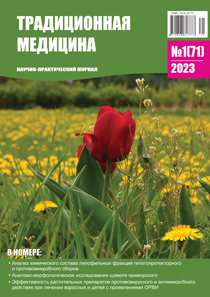Ecological and pharmacognostic assessment of grass quality of common thousand leaf growing in various urb- and agrobiocenoses of Voronezh region
DOI:
https://doi.org/10.54296/18186173_2023_1_30Keywords:
Voronezh region, common thousand, flavonoids, essential oilAbstract
The purpose of the study was to study the accumulation of biologically active substances in the grass of a thousand-leaf common, collected in agricultural and urbobiogeocenoses of the Voronezh region, different from the point of view of anthropogenic impact. All samples of grass prepared under the conditions of agro- and urbocenoses of the Voronezh region of a thousand-leaf common comply with the requirements of the state pharmacopoeia in terms of the quantitative content of essential oil and the sum of flavonoids in terms of luteolin. In general, for samples of control territories and agrobiocenoses, a higher content of essential oil can be noted than in samples of urbobiocenoses. The content of flavonoids in the images of agro- and urbobiogeocenoses of the Voronezh region, on average, is 1.2–2 times higher than in samples of natural biocenoses of protected areas, which is explained by the fact that the enzyme of the key enzyme of their biosynthesis – phenylalaninammiacliase – has a pronounced stress inducibility. It was also noted that as a result of the complex toxic effect on the plant body, which is observed, for example, near large motorways, it is possible to suppress the antioxidant system of the plant and reduce the biosynthesis of flavonol polyphenols. A moderate negative effect on the accumulation of flavonoids of metals such as lead, copper and zinc was noted for the grass of the common thousand, collected in agrobiocenoses. All heavy metals and arsenic defined in the raw materials have a negative effect on the content of this group of essential oils: a strong negative effect was found for lead, mercury, cadmium, nickel, copper, zinc; noticeable – for chromium, arsenic, cobalt. This allows us to conclude about the negative effect of urbanization of the blank site on the accumulation of essential oil in the grass of the common thousand leaf.
References
Дьякова, Н.А. Оценка эффективности и безопасности лекарственного растительного сырья подорожника большого, собранного в Центральном Черноземье / Н.А. Дьякова, А.И. Сливкин, С.П. Гапонов // Вестник ВГУ. Серия: Химия, Биология, Фармация. – 2018. – №1. – С.124–131.
Дьякова, Н.А. Особенности накопления тяжелых металлов и мышьяка в лекарственном растительном сырье тысячелистника обыкновенного, собранного в урбо- и агробиоценозах Воронежской области / Н.А. Дьякова // Вестник Российского университета дружбы народов. Серия: Экология и безопасность жизнедеятельности. – 2020. – №3. – С.213–224.
Накопление флавоноидов травой тысячелистника обыкновенного, собранного в различных урбо- и агробиоценозах Воронежской области / Н.А. Дьякова, А.И. Сливкин, С.П. Гапонов [и др.] // Вестник Воронежского государственного университета. Серия: Химия, Биология, Фармация. – 2020. – №4. – С.71–76.
Куркин, В.А. Фармакогнозия / А.В. Куркин. – Самара: Офорт, 2004. – С.406–410.
In Vitro Antioxidant and Antifungal Properties of Achillea millefolium L. / I. Fierascu, C. Ungureanu, S.M. Avramescu [et al.] // Romanium Biotechnological Letters. – 2015. – №20(4). – Р.10626–10636.
Phenolic compounds from Achillea millefolium L. and their bioactivity / S. Vitalini, G. Beretta, M. Iriti [et al.] // Acta Biochimica Polonica. – 2011. – №58(2). – Р.203–209.
The Essential Oil of Achillea millefolium L. cultivated under Tropical Condition in India / M.M. Nadin, A.A. Malik, J. Ahmad, S.K. Bakshi // World Journal of Agricultural Sciences. – 2011. – №7(5). – Р.561–565.
Intraspecific variability of yarrow (Achillea millefolium L. s.I.) in respect of developmental and chemical traits / K. Baczek, O. Kosakowska, J.L. Przybyl [et al.] // Herba Polonica. – 2015. – №61(3). – Р.37–52.
Баяндина, И.И. Взаимосвязь вторичного метаболизма и химических элементов в лекарственных растениях / И.И. Баяндина, Ю.В. Загурская // Сибирский медицинский журнал. – 2014. – №8. – С.107–111.
Государственная фармакопея Российской Федерации. Издание XIV. Том 4. – М.: ФЭМБ, 2018. – С.6343–6350.
Downloads
Published
How to Cite
Issue
Section
License
Reproduction of any materials without the written permission of the publisher is prohibited.
The responsibility for the accuracy of the information contained in articles and advertisements are the authors and advertisers.






